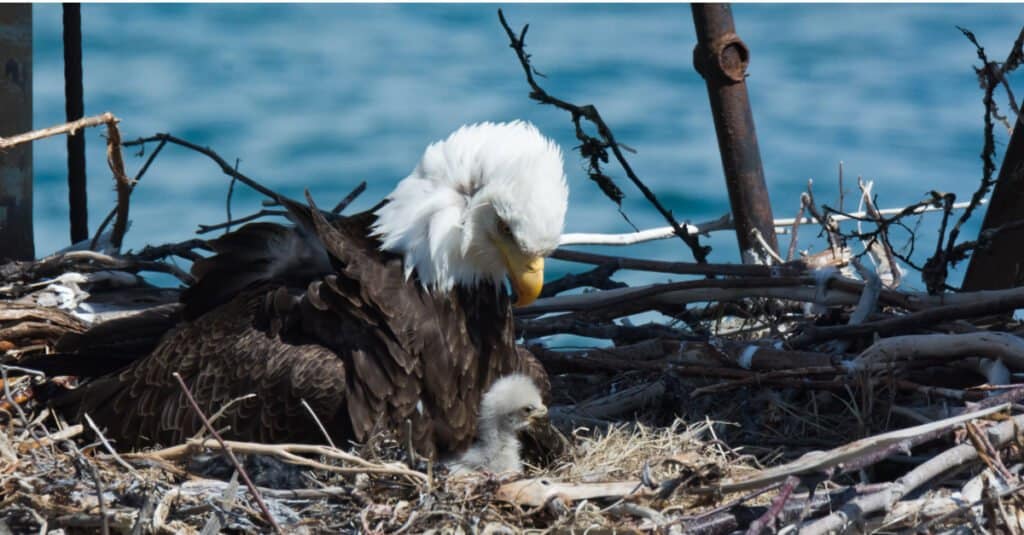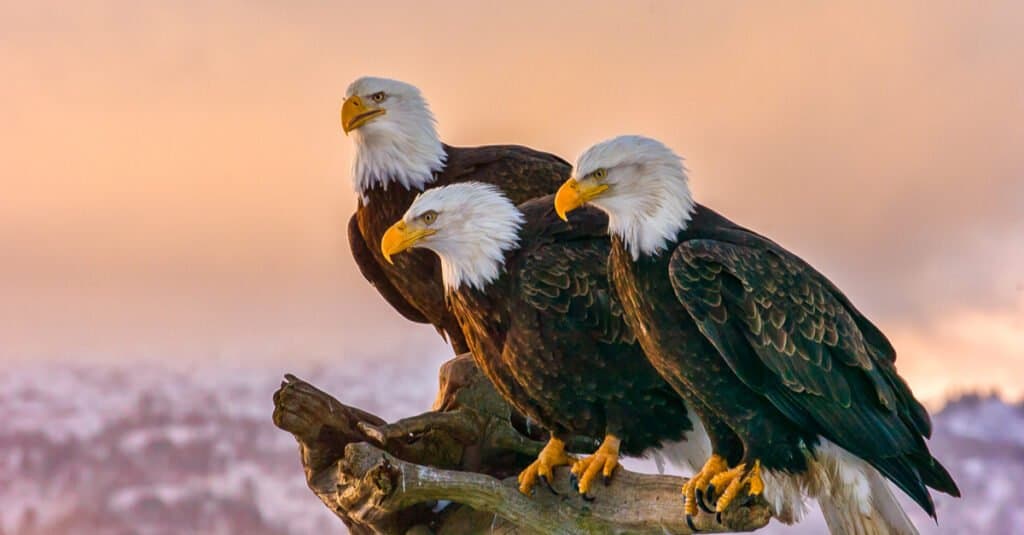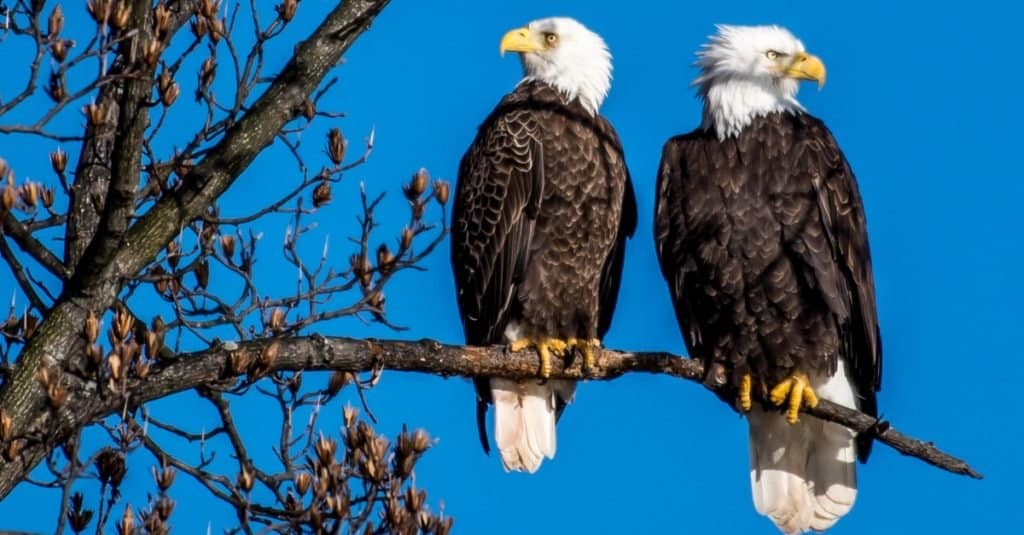The bald eagle (Haliaeetus leucocephalus) was chosen as the national bird of the United States by the Second Continental Congress in 1782. It was placed on the Great Seal of the United States with its wings outstretched. Today, the bird appears on many official government documents and government institutions. The bald eagle is certainly the most pictured bird in America.
The national symbol of the United States is also one of the greatest successes of American conservation. The bald eagle was decimated by the proliferation of certain pesticides, most notably DDT. The pesticide seeped into the nation’s waterways and, therefore, into the fish that are the bald eagle’s primary food source. The chemical caused some bald eagles to stop laying eggs. Many others laid such fragile eggs that they broke during incubation. This chemical caused a dramatic drop in bald eagle reproduction.
At the same time that DDT was doing such extensive damage, bald eagles were also viewed as a threat to poultry and livestock. Farmers and ranchers often killed them. Some hunters saw the bald eagle as a competitor for prized game animals, so they would kill the eagles, as well.

DDT brought bald eagle reproduction rates crashing down.
©Jon C. Beverly/Shutterstock.com
Legal Protections for the Bald Eagle
In 1940, the U.S. Congress passed the Bald and Golden Eagle Protection Act, which made the killing of bald eagles a crime. It was almost too little, too late. By the 1950s, only about 1,000 wild bald eagles remained in the U.S. The bald eagle was further protected under federal endangered species law in 1969. The DDT pesticide was banned in 1972.
Thankfully, these actions were taken in the nick of time. As a result, the bald eagle has experienced a marvelous comeback. That comeback has really picked up steam in recent years. A report from the U.S. Fish and Wildlife Service in 2021 revealed that the U.S. bald eagle population had quadrupled since 2009.
The number of bald eagles in the United States today is well over 300,000, and the numbers continue to rise.

DDT, a once popular insecticide, was banned in theU.S.S in 1972 and later banned for agricultural use worldwide.
©iStock.com/smartstock
Where Do Bald Eagles Live?
These raptors hunt a wide variety of small mammals, reptiles, and amphibians. They will also scavenge carrion. However, as noted earlier, the bulk of their diet is comprised of fish. This is why they often nest near bodies of water.
Bald eagles are found throughout the United States. In fact, Hawaii is the only U.S. state with no bald eagle population at any point during the year.
Rhode Island has a very small scattering of bald eagles, with less than ten nesting pairs in the state. Three more states have few, if any, resident bald eagles, but the eagles visit these states in significant numbers each winter. Nevada, New Mexico, and Utah all host wintering eagles.
Every otherU.S.. state has resident bald eagles year-round. Because these birds typically mate for life, they are counted as nesting pairs in each state.
Alaska has more bald eagles than any other state, and it’s not even remotely close. There are 30,000 nesting pairs of bald eagles in America’s northernmost state. The cold coastal waters, as well as the thousands of lakes and rivers in Alaska’s vast, untouched wilderness, make this state a bald eagle paradise.
But what about the lower 48? Specifically, how do Florida and Texas compare regarding bald eagle populations? These two states in the American South both have healthy bald eagle numbers, but one boasts significantly more nesting pairs than the other.

Alaska has a huge population of bald eagles. These three are perched on tree snag in front of the Kenai Mountains.
©FloridaStock/Shutterstock.com
Bald Eagles in Texas
Texas has 160 nesting pairs of bald eagles. The eagles of the Lone Star State are typically found along its many rivers and lakes. Texas’ bald eagle population goes up significantly in the winter months as many more visiting bald eagles arrive.
Breeding, or resident, bald eagles are found primarily in the eastern half of the state. Wintering eagles typically populate the Panhandle and Central Texas.
Primary locations for bald eagles in Texas are almost always near bodies of water where they can find fish. Bald eagles are becoming a much more common sight around some of Texas’ premier lakes, such as Lake Meredith, Lake Texoma, Lake O’ the Pines, Lake Whitney, Lake Fairfield, Toledo Bend Reservoir, Sam Rayburn Reservoir, Lake Conroe, Lake Buchanan, Lake Palestine, and Lake Warren.
According to the Texas Parks and Wildlife Commission, the greatest challenge to sustaining the bald eagle population in the state will be preventing further habitat destruction and retaining enough creek and river flows to support the fish base needed for both breeding and wintering eagles.

Bald eagles typically mate for life. They are recorded as breeding pairs when eagle populations are surveyed.
©Krumpelman Photography/Shutterstock.com
Bald Eagles in Florida
Florida has a far larger bald eagle population than Texas. But it wasn’t always so strong.
The Florida Fish and Wildlife Conservation Commission has monitored the population of nesting bald eagles in Florida since 1972. That first statewide survey revealed only 44 pairs of bald eagles in Florida.
Today, there are 1,500 pairs of bald eagles in the state, giving Florida the fourth-highest bald eagle population in the nation. Florida only trails Alaska, Minnesota, and Wisconsin in terms of bald eagle numbers.
One reason for the skyrocketing bald eagle numbers in Florida is the easy access to water that teems with fish. Nearly all bald eagle nests in the state are less than two miles from water. The highest concentration of bald eagle nests in the state are found along the Gulf Coast and near the river systems and large inland lakes of the Florida peninsula, such as the Kissimmee Chain of Lakes
Biologists with the Fish and Wildlife Commission .credit the bald eagle’s impressive rebound to several efforts that were interwoven together. Protection of their nesting sites through science-based land management, regulations, public education, and law enforcement all contributed to the bald eagle population boom in the state.
While no longer endangered, Florida’s bald eagle rule is still in place to protect the species.

Bald eagles are often found near bodies of water.
©Jack Molan/Shutterstock.com
The Bald Eagle’s Ecological Importance
Bald eagles play an important role in the health of the ecosystems in Texas, Florida, and everywhere else they are found. When they scavenge carrion, they remove dead and decaying matter from the environment.
Through hunting, they keep populations of animals in check. They often prey on older, sicker, or weaker animals, leaving the strongest members of a species to breed. This enhances the strength and viability of that species.
One of their most important contributions comes from their primary diet of fish. Without predators such as eagles, fish would overpopulate lakes, streams, and other bodies of water. An overpopulation of fish would mean the plants these fish eat would decrease significantly. Many of these aquatic plants serve as nature’s filtration system to keep waterways clean.
The natural balance between predator and prey is vital to the overall health of the natural world, and it has direct and significant impacts on all life, including human life. The domino effect of eradicating a predatory species such as the bald eagle is long and severe. Thankfully proper protections, laws, and public education turned the tide, and the bald eagle is now flying and hunting in nearly every state in theU.S.., including Texas and Florida.

Fish are the primary prey of the bald eagle.
©FloridaStock/Shutterstock.com
The photo featured at the top of this post is © iStock.com/Karel Bock
Thank you for reading! Have some feedback for us? Contact the AZ Animals editorial team.






